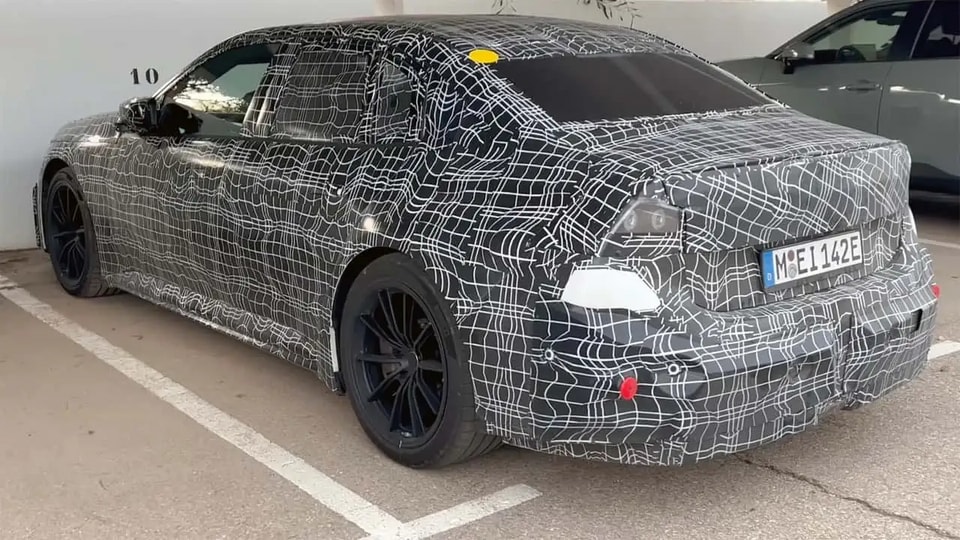BMW M3 EV prototype: Differences and driving expectations
BMW M3 EV prototype revealed with closed grille, no exhaust and lots of camouflage details, appeared with iX3 M version. BMW oriented the Heart of Joy four-motor electric powertrain to recreate M driving style; iX3 M is likely to launch first.
BMW is testing an M3 EV with a distinctly M look that clearly bears the hallmarks of an electric car: a closed grille, no exhaust pipes, and lots of hidden body panels. The performance sedan appears alongside another M prototype that is said to be based on the new iX3, suggesting a product roadmap: the iX3 M could arrive before the official M3 EV.

M3 style with EV signature: recognizable at first sight
The prototype retains the M3’s muscular spirit: wide bodywork, sporty bumpers, and M-specific wheels. However, as an EV, the new M3 has a completely closed grille and no rear exhaust. Compared to the non-M i3, the front bumper on the M3 EV prototype is more prominent, giving it a more grippy feel, while also incorporating aerodynamic improvements for the electric vehicle’s cooling and air distribution needs.
At the rear, the car continues to use a shared door design rather than a set of separate doors. BMW has been criticized for this choice on the petrol M3 before, but the company insists it was more about emphasising the body's muscle than cutting costs. The main lines are still difficult to see completely due to the padding under the camouflage, especially around the ends of the bumpers.
Lights and rims: distinguishing features of the M version
The front headlights appear to be near production-grade, though they’re still partially obscured. At the rear, the prototype uses position lights, while recent non-M i3s have shown production-grade taillights. This could be BMW’s way of differentiating the M3 EV, or it could simply be the state of the test car.
The wheels shown in the video are temporary, and are intended for testing. The finished M wheels will typically feature aerodynamic designs and performance tires; however, the specifics remain a mystery until BMW announces them.
Expected driving experience: four electric motors and wheel-to-wheel torque control
The key to the M3 EV is performance and driving feel. BMW says it wants to use up to four electric motors, which will generate a lot of power and precisely control torque to each wheel. The single-motor-per-wheel configuration opens up a level of traction control, torque distribution, and body response that M engineers can fine-tune to the “playfulness” that makes M famous.
The technology was demonstrated at the Vision Driving Experience (VDX) program, which demonstrated the effectiveness of a new four-motor electric vehicle powertrain called Heart of Joy. At the heart of Heart of Joy is the ability to quickly and precisely modulate torque, providing advantages in acceleration, cornering and stability.
The importance of this move is clear when you consider that current BMW EVs, even the most powerful, have not really won over the driving-enthusiast customer base. The M3 EV – along with the iX3-based crossover in M trim – are expected to reverse that perception.
Appearing with iX3 M: signals about the launch roadmap
In the video, the M3 EV is seen testing alongside an iX3 M prototype. Since the standard iX3 has been revealed and is being tested, it’s likely that the M version of the crossover will be released before the M3 EV. This arrangement makes sense from a product perspective: the iX3 M could serve as a “showcase” for the next-generation powertrain and torque-vectoring algorithm, before it’s applied to the flagship performance sedan.
What's hidden under the disguise
Some details of the prototype are still unclear due to the covering and padding: bumper cover, air vents, rear bumper lip. At the rear, the use of positioning lights instead of the finished taillights shows that there are still many parts that have not been finalized. Even the design of the final rim has not appeared. Important parameters such as power, torque, battery capacity, charging time and weight have not been announced.
With a four-motor configuration, the integration of braking, thermal management and track durability will be the decisive factors in driving feel. BMW has the technical foundation through the VDX and Heart of Joy, but the actual results will depend on the final calibration when the car is commercialized.
Conclusion: M3 EV on the right track, waiting for the answer on the steering wheel
The M3 EV prototype shows that BMW is keeping the visual DNA of the M line while also taking a clear approach to the EV philosophy. More importantly, the four-motor electric orientation and the Heart of Joy platform show that the company is serious about bringing the M experience to electric vehicles. The appearance alongside the iX3 M suggests a launch roadmap: crossover first, performance sedan later.
At this point, the exterior pieces are starting to come into focus, but the core – the driving experience – will only be proven when BMW announces the final version. If the four-motor powertrain lives up to the VDX’s performance credentials, the M3 EV has a chance to be BMW’s most compelling electric car for performance enthusiasts.


